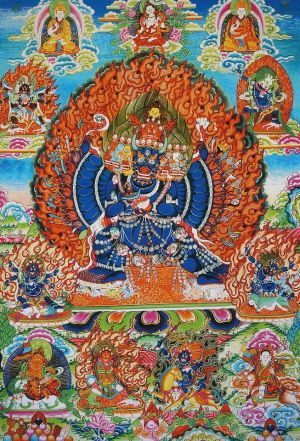Angry Wisdom: Yamantaka, the Destroyer of Death; Vajrabhairava, the wrathful Dharamapala Heruka manifestation of Manjushri, the Buddha of Wisdom
“When the tantric wrathful deity is understood and related to skillfully, it has the necessary qualities to be a catalyst of transformation. One deity that embodies the power to transform the destructive, agressive aspect of the Shadow is Yamantaka. Vajrabhairava, as he is also called is practiced to overcome emotional and karmic obstacles, in particular the violence of anger and hatred.” — The Psychology of Buddhist Tantra, Rob Preece
No deity is more misunderstood, than the buffalo-headed deity Yamantaka [[[Sanskrit]] Vajrabhairava], yet this is one of the main higher practices of the Gelug tradition, and practiced extensively by other traditions. [See “Different forms of Yamantaka” section below.] Yamantaka is, perhaps, most famous in the West because of the intricate and elaborate sand mandalas of Yamantaka:
t is said that when President Nixon was considering aid for Tibet, he saw an image of Yamantaka, complete with horns, and judged that the Tibetan people were primitive demon-worshipers. Of course, modern understanding of the symbolism makes it clear that Yamantaka is a wrathful but compassionate Yidam, whose terrible power is turned against the obstacles to our practice, especially anger, hate, and death.
“Lama Tsongkhapa said, Yamantaka is the most powerful practice in terms of transforming the mind and purification, ” explained H.E. Zasep Rinpoche during teachings at Nelson B.C. on Yamantaka. “It is a very powerful and important practice in this degeneration age.”
Yamantaka practice is a Highest Yoga Tantric practice and REQUIRES initiation to practice safely.
Not only is Yamantaka the most ferocious of the Tibetan meditational deities, everything about him is fierce and almost deliberately “over the top” in scope and scale:
His name “Bhairava” means “terrifier.”
In his name Yamantaka, contains the name “Yama”, the Lord of Death — although when combined with “antaka” it actually means the “Destroyer of Death”
He is visualized in an underworld, a charnal ground filled with demons, spirits, cannibals — but all of whom he brings under his power
He is the “horned” god, and many Westerners see resemblance to Satan’s horns — although they are more akin to the Greek Minotaur or the nature god Kernunos, or Pan.
He is brimming with invulnerable life-force, symbolized through his potently erect penis.
His “shock and awe” imagery is meant to convey unshakable power that cannot be resisted.
He has many arms, legs and faces (depending on which form), his arms holding many weapons, ripe with symbolism.
He stamps on bodies — not as a killer, but as a force that brings all things under his control.
He is surrounded by flames — but not hell-flames; these are the flames of wisdom — for he is none other than the Buddha of Wisdom, Majushri, in his wrathful form.
The many faces of wisdom
Wrathful barely begins to describe Yamantaka. In one of his forms he has nine heads (the central one being a “buffalo”), all with three eyes, fangs and ferocious expressions. In this form he has thirty-four hands, each with symbolic weapons, and sixteen legs. He can also appear solitary, or in union with his consort Vajravetali. He can have two-arms or many. He is normally blue-black, symbolic of many things. Atop his crown, we normally visualize the head of Manjushri, the Buddha of Wisdom.
To the uninitiated, seeing his ferocious image for the first time — just imagine, for example, the early Christian missionaries arriving in Tibet and seeing a near-demonic deity in the temples — he seems frightening, the stuff of nightmares. This is, as it should be. Yamantaka (Vajrabhairava in Sanskrit) is meant to be so fearsome that even the demons — whether you view them as metaphorical inner demons or external entitites — tuck tail and run. Even Yama bows down (the ancient equivalent of Satan or Hades).
Ultimately, death itself is conquered by this towering, wrathful deity, Yamantaka. Conquering death, and the cycle of samsaric suffering, is at the very heart of Buddhism. As the “death destroyer” Yamantaka symbolizes this aspiration, and his meditational deity practice is designed to achieve that goal.
Yamantaka — overcoming anger and hatred
Yamantaka’s ultimate mission is “destroyer of death” (see below)— in the same way, for example, Medicine Buddha’s main mission is “healing” — but, as with all manifestations of the Enlightened, Yamantaka embodies all of the qualities of a Buddha. He does, however, have other well known “specialties.” His practice is famous for overcoming “emotional and karmic obstacles, in particular the violence of anger and hatred.”
Dr. Alexander Berzin explains: “What is it that is going to prevent us from attaining that state of a Buddha? Our own confusion, our own laziness, our own bad temper and anger, our own attachments. This is the real enemy – it’s all these disturbing emotions and negative attitudes in our own minds. So we really need some very, very strong force not to just give in and let ourselves be ruled by this confusion.”
He continues: “We need a combination of compassion – we want to help others – and force and strength that “I’m not going to let all this junk that’s going on in my mind prevent me from being able to help others,” like laziness: “I don’t feel like doing it. I don’t feel like going and helping somebody.” You have to cut through that.”
